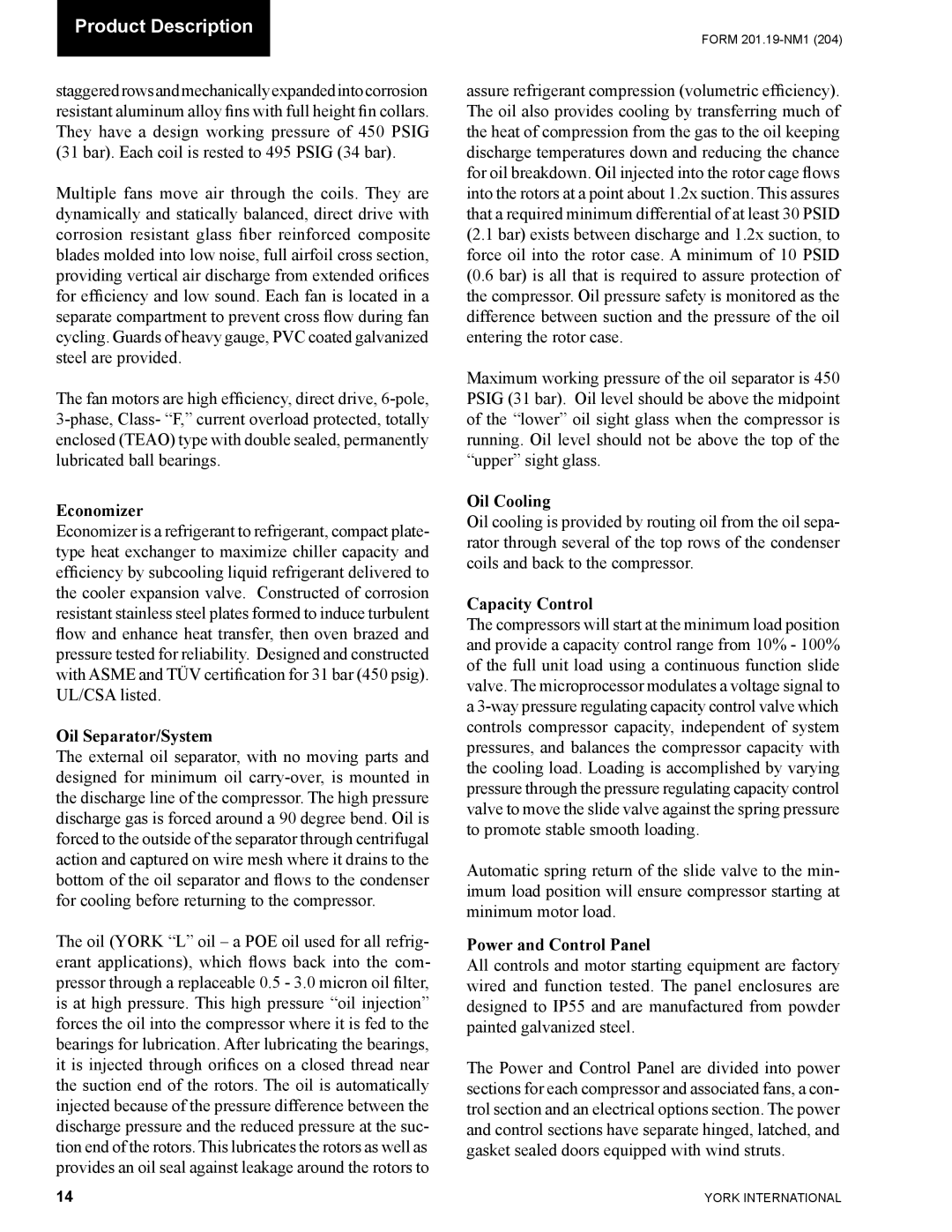Product Description
FORM
staggeredrowsandmechanicallyexpandedintocorrosion resistant aluminum alloy fins with full height fin collars. They have a design working pressure of 450 PSIG (31 bar). Each coil is rested to 495 PSIG (34 bar).
Multiple fans move air through the coils. They are dynamically and statically balanced, direct drive with corrosion resistant glass fiber reinforced composite blades molded into low noise, full airfoil cross section, providing vertical air discharge from extended orifices for efficiency and low sound. Each fan is located in a separate compartment to prevent cross flow during fan cycling. Guards of heavy gauge, PVC coated galvanized steel are provided.
The fan motors are high efficiency, direct drive,
Economizer
Economizer is a refrigerant to refrigerant, compact plate- type heat exchanger to maximize chiller capacity and efficiency by subcooling liquid refrigerant delivered to the cooler expansion valve. Constructed of corrosion resistant stainless steel plates formed to induce turbulent flow and enhance heat transfer, then oven brazed and pressure tested for reliability. Designed and constructed with ASME and TÜV certification for 31 bar (450 psig). UL/CSA listed.
Oil Separator/System
The external oil separator, with no moving parts and designed for minimum oil
The oil (YORK “L” oil – a POE oil used for all refrig- erant applications), which flows back into the com- pressor through a replaceable 0.5 - 3.0 micron oil filter, is at high pressure. This high pressure “oil injection” forces the oil into the compressor where it is fed to the bearings for lubrication. After lubricating the bearings, it is injected through orifices on a closed thread near the suction end of the rotors. The oil is automatically injected because of the pressure difference between the discharge pressure and the reduced pressure at the suc- tion end of the rotors. This lubricates the rotors as well as provides an oil seal against leakage around the rotors to
assure refrigerant compression (volumetric efficiency). The oil also provides cooling by transferring much of the heat of compression from the gas to the oil keeping discharge temperatures down and reducing the chance for oil breakdown. Oil injected into the rotor cage flows into the rotors at a point about 1.2x suction. This assures that a required minimum differential of at least 30 PSID (2.1 bar) exists between discharge and 1.2x suction, to force oil into the rotor case. A minimum of 10 PSID (0.6 bar) is all that is required to assure protection of the compressor. Oil pressure safety is monitored as the difference between suction and the pressure of the oil entering the rotor case.
Maximum working pressure of the oil separator is 450 PSIG (31 bar). Oil level should be above the midpoint of the “lower” oil sight glass when the compressor is running. Oil level should not be above the top of the “upper” sight glass.
Oil Cooling
Oil cooling is provided by routing oil from the oil sepa- rator through several of the top rows of the condenser coils and back to the compressor.
Capacity Control
The compressors will start at the minimum load position and provide a capacity control range from 10% - 100% of the full unit load using a continuous function slide valve. The microprocessor modulates a voltage signal to a
Automatic spring return of the slide valve to the min- imum load position will ensure compressor starting at minimum motor load.
Power and Control Panel
All controls and motor starting equipment are factory wired and function tested. The panel enclosures are designed to IP55 and are manufactured from powder painted galvanized steel.
The Power and Control Panel are divided into power sections for each compressor and associated fans, a con- trol section and an electrical options section. The power and control sections have separate hinged, latched, and gasket sealed doors equipped with wind struts.
14 | YORK INTERNATIONAL |
